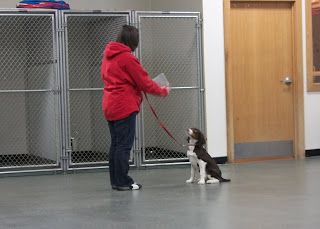In our second installment of fun things to do with your dogs we are introducing information on the sport called DISC DOGS:
Disc dog is the more generic name for what is commonly called Frisbee dog. In disc dog competitions, dogs and their human disc throwers compete in events such as distance catching and somewhat choreographed freestyle catching. The sport celebrates the bond between handler and dog, by allowing them to work together. The term "disc" is preferred because "Frisbee" is a trademark (held by Wham-O) for a brand of flying disc.
Format
Teams of one person and one dog compete in the standard distance "toss and fetch" event. Points are awarded to the team for catches at varying distances. Competitions also often feature the dynamic freestyle event, which consists of short routines choregraphed to music with multiple discs in play. The less common long distance events have various formats, but generally the longest catch wins.
Divisions in frisbee dog events are usually based on the skill and experience of the handler. Men and women generally compete in the same divisions for all disciplines, although the long distance category is sometimes divided by gender.
Toss and fetch
Short distance events go by many names, including Toss and Fetch, MiniDistance, Throw and Catch, and Distance/Accuracy. The concept is generally the same. Contestants have 60 seconds to make as many throws as possible on a field marked with increasingly longer distances. The distances generally don't exceed 50 meters for the longest catches. Dogs are awarded points for catches based on the distance of the throw, with mid-air catches rating extra points (in most contests an extra half point when the dog is completely airborne for the catch). Only one disc is used for these events.
Freestyle
Freestyle is a subjectively judged event, similar to Freestyle events like skateboard and snowboard half-pipe, or Freestyle Footbag (Hacky Sack). The team consists of one person (handler) and his or her dog. Depending on the event, the length of a routine might be anywhere from one minute and 30 seconds all the way to three minutes. Teams are judged in categories that include Canine Athleticism, Degree of Difficulty, Showmanship, and so forth. Incredible flips, hyperfast multiple catches, and spectacular vaults make freestyle a popular event with spectators, and it is regarded as the highest level of competitive accomplishment.
Competitions
Today there are several organizations running disc dog tournaments. Most competitions take place in the summer on flat, grassy fields. Winter disc dog contests on soft snow are also popular in places.
Benefits
Dogs of all kinds can play Frisbee. Many World Champion disc dogs have been mixed breed and some were originally rescued from shelters. Dogs from animal shelters and rescue groups can excel at catching flying discs and may even find the activity helpful in overcoming past trauma. Problems that lead to a dog being abandoned, such as hyperactivity, aggression, and destructive or neurotic behavior, are often attributes that can be positively channeled into a sport like flying discs. Sometimes these dogs simply need a consistent job to keep them busy and give them purpose. Many Frisbee dogs also "cross-train" in other dog sports, including agility, flyball, sheepdog trials, and obedience.
Popularity
Part of the popularity of the sport is its accessibility. All that is necessary to enjoy it is a level playing area, a dog, and a flying disc. Also, a little imagination is an extra plus for Freestyle competition. It is estimated that over one million dogs play flying disc in the United States alone, though only a small percentage participate in organized competitions.
Disc dogs are also popular attractions at sporting events as half-time entertainment. Going clear back to Ashley and his 8th inning performance in 1974, Frisbee dogs have performed at countless football, basketball, baseball and soccer halftimes. They are many times found in amusement parks, county fairs and pet festivals of all kinds. There are a very small handful of trainers who even make a living doing these shows.
Disc dog clubs
Disc dog clubs organize and promote the sport on a local level, and work with national organizations to run events. They offer new-comers a way to learn more about the sport, and are a great place for the experienced competitors to give back. Disc dog clubs are usually active in local animal charities, helping to raise money and awareness for such groups. Disc dog clubs can be found all over the United States.. The first club was the Dallas Dog and Disc Club, founded in the mid-1980's by Ron Ellis.
Disc dog training
Not all dogs immediately understand the concept of the game. A dog may not instinctively know to turn and chase after a disc that is thrown over its head. To begin, the disc should be thrown straight to the dog at a short distance. Once a dog knows how to catch, it can learn the additional concept of running to catch the disc. The disc should be thrown at increasing heights, gradually throwing the disc higher, until it finally goes over the dog's head. At that point the dog instinctively follows the disc all the way around.
Information gathered from various sources including but not limited to Wikipedia
















